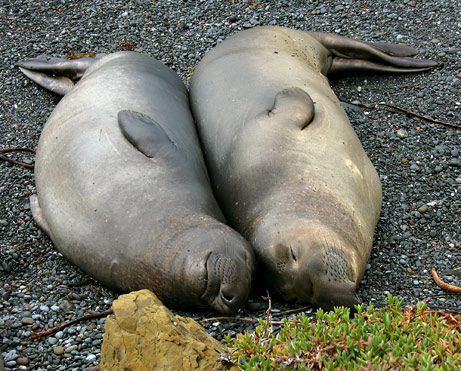
Moving from their breeding colonies in California to their wintering areas in the mid-Pacific and around Alaska, the seals spend two to eight months at sea without a single pit stop.
There's no land to climb on along the roughly 2,000- to 3,000-mile (3,200- to 4,800-kilometer) voyage, and the seabed is often miles below the surface.
The marine mammals' grueling trek had many researchers wondering: When and how do elephant seals sleep?
It's long been known that, during the seals' epic migrations, the animals engage in repetitive dives down to depths of 984 feet (300 meters) or more.
Now a study of young elephant seals has revealed that during some of these dives, elephant seals roll on their backs and allow themselves to sink.
The seals wobble as they drift down, and most of the time their bodies follow circular paths toward the bottom of the sea, said study co-author Russel Andrews, of the University of Alaska, Fairbanks.
"[They] resemble a leaf that has dropped from a tree branch and is falling toward the ground, fluttering from side to side," he said.
These slow periods of aimless drifting suggest to the researchers that the seals are resting - and maybe even catching a few Zs.
Deep Sleeping Seals?
Other marine mammals, such as whales and dolphins, are thought to sleep on the move by shutting down half of their brains at a time.
Those animals float along the surface, remaining alert to predators while giving part of their brains a rest.
But elephant seals rarely spend more than a few minutes on the surface during their migrations, and seals have never shown the same one-sided brain activity that dolphins and whales do during lab studies.
"Elephant seals apparently can't rest and remain vigilant at the same time, so we figured they were using an alternative solution," Andrews said.
To investigate, a team led by Yuko Mitani, of the National Institute of Polar Research in Tokyo, fitted six juvenile elephant seals from California's Año Nuevo State Reserve with data loggers.
The tags had been designed to record the seals' speeds, depths, temperatures, three-dimensional movements, and locations.
The seals were then released about 21 to 43 miles (35 to 70 kilometers) away and tracked as they made their way back to the Año Nuevo reserve, a trip that took the seals one to five days to complete.
"Fortunately for us, as the seals swam back to the rookery, they performed the same kind of repetitive, deep-diving behavior that they do on their migrations across the Pacific," Andrews said.
And during some of those dives, the tags revealed, the seals fluttered like leaves toward the ocean floor. Mitani's team thinks this method of sinking allows the seals to rest without falling too far too fast.
Sleeping at depth, Mitani added, could be a defense mechanism - the technique would allow the seals to rest in a part of the water column where fewer predators reside.
Findings published online October 28 in the journal Biology Letters.



Reader Comments
to our Newsletter